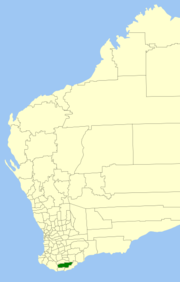Shire of Plantagenet
|
Shire of Plantagenet Western Australia |
|||||||||||||
|---|---|---|---|---|---|---|---|---|---|---|---|---|---|
 |
|||||||||||||
| Population | 5,182 (2013 est) | ||||||||||||
| • Density | 1.08139/km2 (2.8008/sq mi) | ||||||||||||
| Established | 1871 | ||||||||||||
| Area | 4,792 km2 (1,850.2 sq mi) | ||||||||||||
| President | Cr Ken Clements | ||||||||||||
| Council seat | Mount Barker | ||||||||||||
| Region | Great Southern | ||||||||||||
| State electorate(s) | Blackwood-Stirling | ||||||||||||
| Federal Division(s) | O'Connor | ||||||||||||
 |
|||||||||||||
| Website | Shire of Plantagenet | ||||||||||||
|
|||||||||||||
The Shire of Plantagenet is a local government area in the Great Southern region of Western Australia, managed from the town of Mount Barker, 360 kilometres (224 mi) south of Perth and 50 kilometres (31 mi) north of Albany. The shire covers an area of 4,792 square kilometres (1,850 sq mi) and includes the communities of Narrikup, Rocky Gully, Kendenup and Porongurup.
The region is noted for agriculture, principally wheat, sheep (wool and meat), beef cattle, wine, canola and olives. Silviculture, especially plantations of Tasmanian Blue Gums (Eucalyptus globulus), was a major industry in the shire although some recent silviculture enterprises (Great Southern Plantations and Timbercorp) have gone into receivership. Local tourist attractions include the Porongurup Range and Stirling Range, a museum based within the original police station, and other pioneer structures such as St Werburghs Chapel.
The Plantagenet Road Board was gazetted on 24 January 1871 as one of 18 elected boards to manage roads and services in Western Australia, and initially included a reasonably large section of the Great Southern region. On 1 July 1961, it became the Shire of Plantagenet following the enactment of the Local Government Act.
...
Wikipedia
